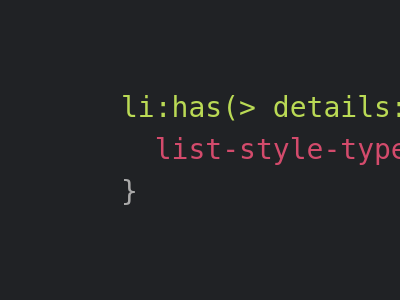:has() has landed
Extra
:has() has been the last entry in my recently published list of major (new) CSS features. And I concluded:
Game changer! Bigger than all of the above.
And yet, there has been no occurance of this powerful selector on this site. Fair enough, it’s only been a couple of weeks since we got cross-browser support.
A dash of :has()
Lately, I’ve been adding a dash of :has() to my pull requests at work whenever possible. So it would only be matter of time until the same is true on my personal site. Last night, while I added support for <details> and <summary>[1], it finally happened.
When I looked at the commit, I found my first personal use of :has() to be rather unusual, which inspired this blog post.
Let me write down what I ended up with verbatim:
li:has(> details:only-child) {
list-style-type: none;
}
li:has(> details:only-child) summary {
list-style-position: outside;
}This essentially removes the bullet in every list item that contains a <details> element (and nothing else), and turns the <summary> triangle marker (i.e. its expanded/collapsed indicator) into the list item’s indicator.
While this may be a bit too much of an edge case to end up in somebody’s CSS Reset, I found it cool enough to write about it, because it works without any additional styles.[2]. In other words, it can be thrown on top of browsers’ bare user agent styles, which is exactly what I did in the accompanying CodePen.
Showcase
View “Details/Summary indicators as list item bullets” on CodePen.
Footnotes
- Another first on this site. While
<details>and<summary>play an important role on one of my subdomains, my blog managed to get by without them, that is, until I published the note »Seemingly bookmarked«. ↩︎ list-style-position: outsideputs the marker outside of the focus ring, so in reality you may want to tweak that too. But you get the idea. ↩︎